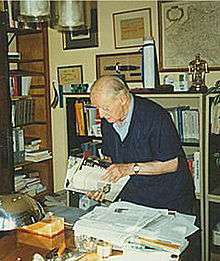Giedroyc Doctrine

The Giedroyc doctrine (pronounced [ˈɡʲɛdrɔjt͡s]; Polish: doktryna Giedroycia) was a political doctrine that urged reconciliation among East-Central and East European countries. It was developed by postwar Polish émigrés, and was named for Jerzy Giedroyc, a Polish émigré publicist.
Giedroyc developed the doctrine in the 1970s in the journal Kultura with Juliusz Mieroszewski (the doctrine is sometimes called the Giedroyc-Mieroszewski doctrine[1][2]) and other émigrés of the "Maisons-Laffitte group".[1][3][4][5][6] The doctrine can be traced to the interwar Prometheist project of Józef Piłsudski.[6]
The doctrine urged the need to rebuild good relations among East-Central and East European countries. This called for Poland to reject any imperial ambitions and controversial territorial claims, and to accept the postwar border changes.[3][5][6] The doctrine supported independence for Belarus and Ukraine.[3] It also advocated treating all East European countries as equal in importance to Russia, and refusing special treatment for Russia.[1][4] The doctrine was not hostile to Russia, but called on both Poland and Russia to abandon their struggle over domination of other East European countries — in this context, mainly the Baltic states, Belarus, and Ukraine (hence another name for the doctrine: the "ULB doctrine", where "ULB" stands for "Ukraine, Lithuania, Belarus").[1][3][4][5]
The doctrine supported the European Union and aimed at removing East-Central and East European countries from the Soviet sphere of influence.[3] After Poland regained its independence from Soviet influence following the fall of communism in 1989, the doctrine was implemented in Poland's eastern foreign policies. Poland itself began integrating into the European Union, eventually joining the EU in 2004.[3][4][6] Poland has likewise supported Ukrainian membership in the European Union and NATO.[3] The doctrine has resulted in some tensions in Polish-Russian relations.[3]
The doctrine has been questioned by some commentators and politicians, particularly in the 21st century,[4] and it has been suggested that in recent years the doctrine has been abandoned by the Polish Foreign Ministry.[5] Others, however, argue that the policy remains in force and is endorsed by the Polish Foreign Ministry.[1][7]
See also
References
- 1 2 3 4 5 Živilė Dambrauskaitė, Tomas Janeliūnas, Vytis Jurkonis, Vytautas Sirijos Gira, Lithuanian – Polish Relations Reconsidered: A Constrained Bilateral Agenda or an Empty Strategic Partnership?, pp. 126–27 online, also (PDF) http://www.lfpr.lt/uploads/File/2011-26/Dambrauskaite%20el%20al.pdf. Missing or empty
|title=(help) - ↑ Nazwa *. "Do uczniów Giedroycia | Tygodnik "Przegląd"". Przeglad-tygodnik.pl. Retrieved 2013-03-07.
- 1 2 3 4 5 6 7 8 Aleks Szczerbiak (23 April 2012). Poland within the European Union: New Awkward Partner or New Heart of Europe?. CRC Press. pp. 1904–1905. ISBN 978-1-134-17902-2. Retrieved 7 March 2013.
- 1 2 3 4 5 Piotr A. Maciążek, Słownik Polityki Wschodniej. Polityka Wschodnia, 2011
- 1 2 3 4 "The Giedroyc era ended in foreign policy". Liberte World. 2011-03-08. Retrieved 2013-03-07.
- 1 2 3 4 Andreas Lorek (February 2009). Poland's Role in the Development of an 'Eastern Dimension' of the European Union. GRIN Verlag. pp. 23–24. ISBN 978-3-640-25671-6. Retrieved 7 March 2013.
- ↑ "O Giedroycia sporu nie ma. Rozmowa z Radosławem Sikorskim", Nowa Europa Wschodnia 1/2010, pp. 69–77.
External links
- „Jeśli nie ULB, to co? Doktryna Giedroycia w XXI w.” ("If Not ULB, Then What? The Giedroyc Doctrine in the 21st Century", 17 June 2010)
- Bartłomiej Sienkiewicz, "Pożegnanie z Giedroyciem" ("Farewell to Giedroyc", Rzeczpospolita, 28-05-2010).
- Zdzisław Najder, "'Doktryna ULB – koncepcja Giedroycia i Mieroszewskiego w XXI wieku" ("The ULB Doctrine: Giedroyc's and Mieroszewski's Concept in the 21st century"). .
- Marcin Wojciechowski, "Co po Giedroyciu? Giedroyc!" ("What Comes after Giedroyc? Giedroyc!"), Nowa Europa Wschodnia (New Eastern Europe), 1/2010, pp. 69–77.